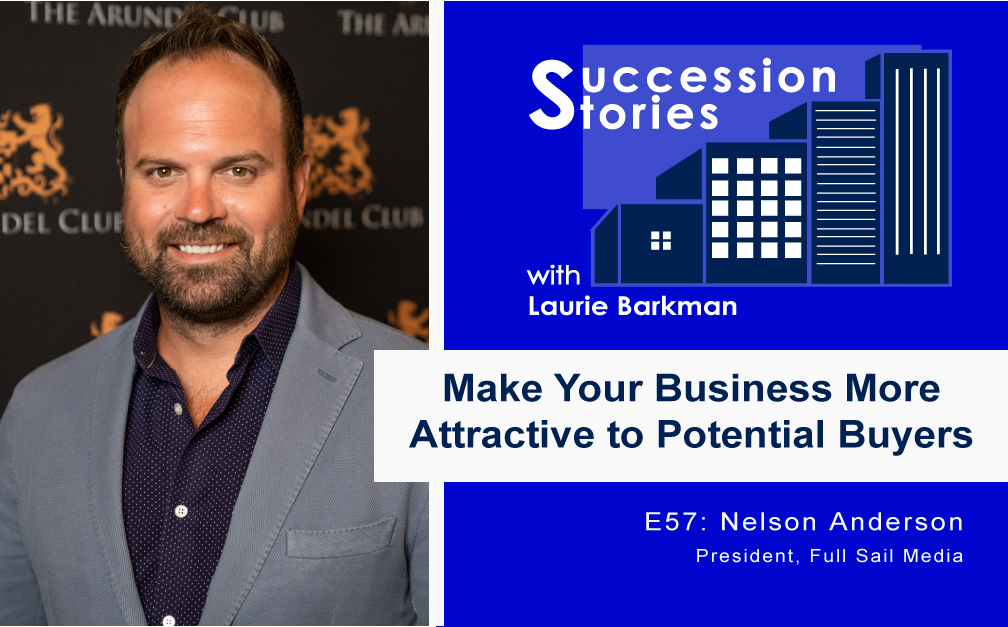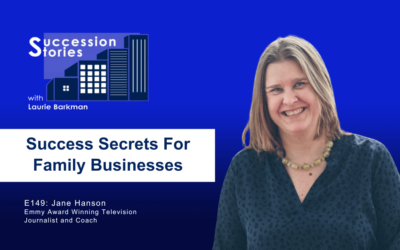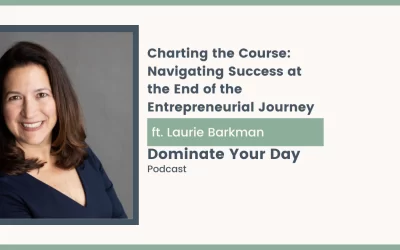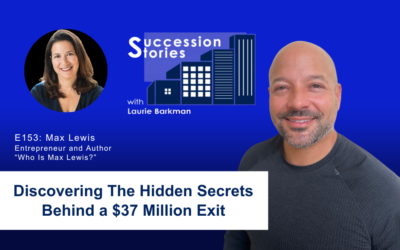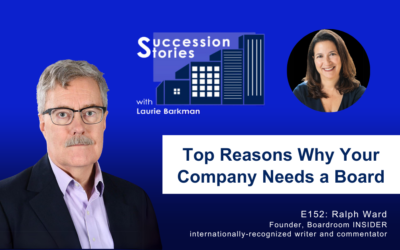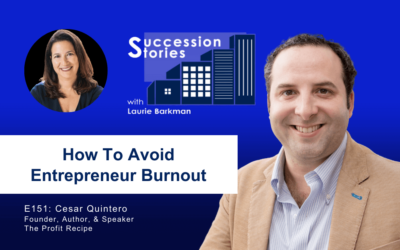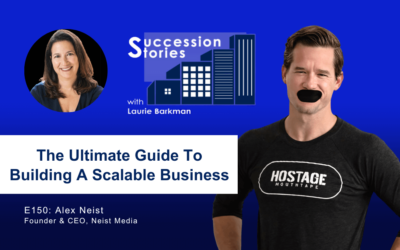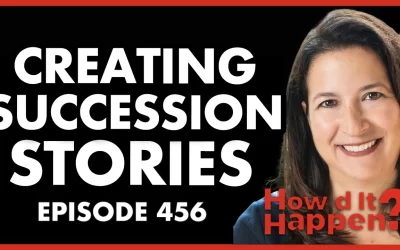How can strategic acquisitions fit within organizations as tuck-ins? Sixteen years ago, Nelson Anderson bought a small printing franchise from his father-in-law. And for 10 years, he did it all – from sales to operations and more. With the helpful guidance of trusted advisors, Nelson built a team and processes that enabled him to step back, a hard thing to do but has enabled their growth through acquisition. This approach has helped Full Sail Media grow from a small $400,000 print shop to a multifaceted marketing company that’s over $8 million in revenue. Make your business more attractive to a potential buyer, and listen to Nelson’s suggestions for what you should start doing today.
Listen in to learn more about:
- Letting go as a small business owner
- Actionable insights that you can apply in your business to make it more attractive to buyers
- Fostering mutual interest during transition
- Aligning values, culture & priorities in the M&A process
Episode Transcript
Laurie Barkman:
Nelson Anderson, welcome to Succession Stories. You and I have been waiting for months for this conversation so I’m really excited. We met last December, which seems like eons ago, and so much has happened. I’m excited to talk to you not only about your background as a business owner and someone who’s made some changes in his business over the years, but someone who’s also started to acquire companies. I think your journey is going to be really relevant and interesting for business owners who have been contemplating either getting sold, or buying businesses to tuck in for their growth. So welcome.
Nelson Anderson:
Thank you so much for having me on. Laurie, I appreciate it. Glad we could find time.
Laurie Barkman:
Me too. You’ve been very busy. It’s all good stuff and I’m sure we’ll cover it today. Let’s talk about you first, just give us a little bit of background about you and what you do.
Nelson Anderson:
Sure, so a little bit of background about me. I started by buying a Minuteman Press from my father in law. It was a small shop, about four people and over time, we grew. We’ve been doing this for 16 years now,, and we’ve probably purchased about five companies over that time, in different segments that have allowed us to grow in strategic areas, and ones that haven’t been so good. [Laughs] We can talk about that. We went from four people to now we’re about 50 and we have several different segments to our business with an overarching company called Full Sail media as a marketing umbrella, sales umbrella but then having the output of printing direct mail wide format and these marketing services.
Laurie Barkman:
And we should add that you are in the Baltimore area.
Nelson Anderson:
Yeah, down here in Baltimore. Just south Baltimore, looking to move into Baltimore proper here soon so we’ll see how that goes.
Laurie Barkman:
Yeah, you and I had chatted about that. I got married in Baltimore so I have a big affinity for the city. It’s a great town.
Nelson Anderson:
Yeah.
Laurie Barkman:
Let’s talk about Minuteman Press. You bought the franchise from your father in law, and that began your journey. What was that like? Were you doing this on your own, bootstrapping it and working 70 hour weeks and coming home late for dinner?
Nelson Anderson:
You nailed it. I was in IT sales of all things. Prior to that I was just a baby. I was 23 years old and my father in law came up with a discounted purchase price to sell to me for. I mortgaged my house and he held the rest of the note. My wife worked for her father so we worked together. I had no clue on print, I just knew how to sell and then quickly learned about business. I didn’t go to college, I went to a Christian School in Annapolis. It was like college prep, but I did not do well; it wasn’t my thing I wanted to work. We got started and I’ll never forget those first few months and trying to learn how to read a P&L, and I’m realizing, “How is this going to work?” I was used to making pretty good money selling IT, and I realized quickly that it’s all about market share, and taking care of customers and getting them to come back. I’ll fast forward to about 10 years into the journey. We had constant growth for about 10 years. We went from $400,000 in sales when I bought the company and probably 10 years ago, we were $3 million, maybe $4 million in sales and revenue. That’s really where things broke down for me.
Laurie Barkman:
Broke down how?
Nelson Anderson:
You’re used to doing everything and having your finger on the pulse, and then it gets to a point where there’s too many jobs, there’s too many things, there’s too many employees, that you just can’t do it all yourself. As much as I thought I was Superman and the hero – and I like to play that part, that’s fulfilling – the only way for me to scale and continue to grow and build a business that is sustainable without me and that services the customer really well – I mean that’s at our heart, our heart is that we want a customer experience that is above all others and that the customer wins, so that’s that’s part of our mission, our core values is customer success – I needed to develop the right people around me. We started hiring people. I say “we”, it was me, and I’m a terrible hirer, interviewer. If I liked the person, I would hire them.
Laurie Barkman:
No matter what skills they have, doesn’t matter.
Nelson Anderson:
Right. Like, “I like you. You’re cool. I can have a beer with you.” So I had to do some learning and I never really had anybody, like, I didn’t have a mentor; I didn’t have a business mentor. I went on the search, then, after some failed hires, and people not working out I got two people that I was able to lean on. One was a Christian CEO group that I started to go to, it’s now called CXP, Ken, I’ll drop his name because he’s a sweetheart of a guy. He just moved down to Florida. He was instrumental in helping me through all the stuff going on in your head, as the loan guy at the top and then also just how to deal with the interpersonal part of the executive team. Then I also reached out to Print & Graphics Association MidAtlantic who connected me with a print-specific consultant. He was out of Indianapolis, and I never forget this, Laurie. I was like, “I’ve had some false starts with consultants,” meaning like, you think they want to do well for you, and they talk to you about what they can do for you and it just doesn’t work out. It really comes down to do you guys jive? Do they have that experience of doing just what you need? Have they done it before? I’ll never forget, I flew out to Indianapolis for a day, this guy’s like, “Who’s flying out to meet me for a day?” He called the main guy that set the whole thing up that recommended him, and he’s like, “Who is this guy?” We kicked off, had a great lunch and ended up talking for four hours until I had to get back on the plane and come back. That was probably about five years ago and he’s still my consultant, he comes on our leadership retreats, we talk every week, and he’s just been an instrumental part of our growth and in my personal development as an owner.
Laurie Barkman:
That’s fantastic so let’s rewind just a little bit because I think this trajectory that you talked about took about 10 years to – let’s call it 10x – the business. You started out around 400,000 in revenue, got to about 4 million, and then you said, “Wow, I’m hitting a wall,” and when you said everybody was reporting to you, you probably had part time employees, but then did you also have full time employees?
Nelson Anderson:
Yeah, at that time, we probably were in the 25 employee range at that revenue level, maybe a few more.
Laurie Barkman:
If you had an org chart, because you’re a printing company you can print a really wide, really long org chart…
Nelson Anderson:
Yeah. With me and then everybody.
Laurie Barkman:
[Laughs] You have the printing for that.
Nelson Anderson:
We could print it, it just couldn’t make sense.
Laurie Barkman:
So you started to hire some wrong people and you started to find some right people, who was a really key hire for you? What were you looking for in what I call a 2IC, a second in command. What did you find in that person?
Nelson Anderson:
I ended up finding that person about three years ago and, I will say that we’ve had others in place, and they were the right person for the right time and growth. If I had to do it all over again, I had a great guy that I hired that helped me with production, he was the production guy, I was a sales guy and we had a great Ying Yang. The issue was, he didn’t have experience at a larger company. So through the period that I had him there until five, six million, he was great. He was the perfect person for this position, until that point, to develop processes and implement processes. So it was very uncomfortable because of not speaking directly and talking about these things early on in the stage. He brought tremendous value to the business but the position that was held, which is my number two, my right hand, he hit a ceiling and we ended up parting ways. Still talk today, still friends, but I ended up – for this level we are at right now – I hired an operations officer that has print experience for 30 plus years at a much larger company and he has been just great for our continued growth. He’s been through acquisitions, and in tuck-ins, and been up and been down, so when we experienced COVID, he was, he’s experienced times like that in business so he’s just a goldmine when we went through this, and it helped me walk through that time.
Laurie Barkman:
Alright, so take me back a little bit. You’re still growing, you’re realizing you can’t do it all, we call this the owners trap – especially when you the owner, are in charge of sales and very involved in the sales process and then everybody’s bouncing back to you – we call that the owners trap. You realized that you really didn’t want to be in that trap and you were looking for a way out. You surrounded yourself with some smart people who could balance out your skill set and operations in other areas. Were these then the boon years? Or did you hit another challenge before you started to acquire companies? What got you to that point where you said, “Where we are headed now is not where I want to be, I want to change my strategy.”
Nelson Anderson:
I would say, that’s really two separate conversations around acquiring companies and really building the management team. Jeff, my Operations Officer right now, was a great addition to the team and he’s my right hand guy. However, we have my sister Susan, who came to work for me about seven years ago, and has grown. She started doing accounting work and customer service, and now she’s in charge of our management system. We would be lost without her. Then the other person on my management team is my controller, Ian. As a small business owner, it was like letting go of these things. I would do the Quick Books and pay people and run and get checks, and write up orders, and then just peeling off these little pieces to people that you can trust. Ian has been a friend of mine for 20 years and so the person that’s handling your money, you got to be able to trust. That was how that relationship came about and that doesn’t come without its struggles. He’s a friend and so it’s really difficult to have hard conversations with him, but he has my best interests in mind, and the company’s interests in mind. When you keep that at the forefront, you never lose your track. You never lose your way because we care about each other.
Laurie Barkman:
That’s great and your sister’s in the company. I didn’t know that.
Nelson Anderson:
Yeah, so it was just supposed to be, “Come help me out.” It’s been the gal Friday that does everything that’s needed; a Swiss Army knife, if you will, and has grown, personally developed, and she didn’t have a print background or anything along those lines and just has done a wonderful job here.
Laurie Barkman:
That’s fantastic. Let’s go then to talk about your approach to acquiring companies. What type of deals do you look for, and how do you integrate these businesses?
Nelson Anderson:
Great question so our first acquisition. It’s always been a strategy of ours even before, you know, the growth strategy is, “Hey, we need market share.” But not only market share it was, “How can we serve the customer? What are they asking for?” I’ve never grown the business because I want to do X. I didn’t want to get into the printing business so to speak. it wasn’t like, “Oh, printing’s sexy I want to do that.” It was, “I want to be of service to the customer. I want to help people,” and so we allow the customer to dictate where we grow. The first acquisition that we did was actually a small mailing company that we had done work with. If we were printing it we would take it to them to mail it in the mail for us. I think it was in 2008 that we did that. They had hit on some hard times and the relationship was there. I think that is the common thread throughout all of these, the one that’s have worked, and the ones that necessarily haven’t worked is it was it added value to the customer. Then also we were in sync meaning the owner and I and we had the same principles, we got along and we managed businesses the same way, managed people’s relationships the same way. That’s really important when it comes to retaining the employees and getting them into the culture, it just takes a long time in order to make sure that this is going to fit right. Anytime we’ve done an acquisition, I like to call it 50 first dates. It is like going right back to dating, although I didn’t really do that, I married my high school sweetheart but I can imagine. It’s finding out deeply about these people, what makes them tick, and just getting to know them and becoming friends with them.
Laurie Barkman:
There’s a lot of small businesses that were struggling around the 2008-2009 crisis and even today. Do you find that it’s the very reason for their wanting to sell? Or is it because they don’t have family in the business and they’re looking for a succession option? Or do you find it’s a mix of both?
Nelson Anderson:
I would say that’s really been the only time that that has happened, where it was a downturn and they just wanted out, but he had another business that he was active in so this was a side business. He wanted to go off and work on the other business that was being successful for him and producing the most cash and get rid of this distraction and so it was just a perfect fit. We needed it, we were doing it, we were his biggest customer so it made sense. I would say the other ones are what you just said; they’re done. They’re ready, they’ve done this, they’ve handled customers, they’ve done the AP, the AR, they’re tired of writing orders, they’re tired of managing people, it’s exhausting. It’s also the most rewarding. So that’s what we have found, as we’ve done the other acquisitions is it’s they want an off ramp. Some want to stay and some just want to be gone. The most recent acquisition that we just did was AT Direct, again a direct mailer that we have known over the years, have done work for, they bring another level of expertise to our direct mail, and really are on the forefront and the strategy around direct mail and also produce it. Judy Antisdel is the owner of AT Direct and now she has come to work for me. She’s here, we retained 100% of the employees when we did that, because we were stretched at the time so it was a great addition. We found great employees that have been with her for 18-20 years in her 30 year journey and so I’m just so excited to have her here. She’s excited to focus on being with customers and talking about direct mail strategy and then integrating all the other services that we have to offer because we’re a full commercial shop and we also have our digital marketing company, Full Sail media that we can add to direct mail, which just like 4x results for our customers.
Laurie Barkman:
That’s really powerful. Let’s talk about the process of acquiring a company. Did you use an intermediary, an M&A advisor or a broker to help you in these negotiations? How did you know how to value the business and what to offer the business owner?
Nelson Anderson:
That is a great question. I’ve relied heavily on three people so it’s really important that you are connected with people that you trust, that can walk you through it. Every deal is different. They look the same from a 10,000 foot view, but they’re all different. All owners want something a little bit different and I would say that the common thread for all owners is they want number one, their employees taken care of over themselves and number two, they want their customers taken care of over themselves. Money’s always third. So they want to know how are their employees going to be? How is this going to be for their customers that they’ve worked their butts off for in this case, 30 years to take care of and retain. I use, like I said, three people, my print consultant is number one, my lawyer number two, and number three is my accountant. So I will get a conference call with the three of them and we will look at this, and brainstorm how we can achieve what the seller wants, and how it works into us and all the pickups that we have. All of the acquisitions that we’ve done have been tuck-ins, meaning, an earnout, tuck-in situation where it might be some money upfront, a certain amount paid over time based on sales and in some cases, the owner stays on for a period of time, and in some cases, they go away and they want to go away.
Laurie Barkman:
How many acquisitions have you done now over the last few years?
Nelson Anderson:
I think it’s been about five acquisitions and ranging in direct mail, other printers, print brokers, and we still have the majority of the employees from those acquisitions.
Laurie Barkman:
When you value these businesses, are you doing it as a multiple of their pre-tax profits?
Nelson Anderson:
Correct. We take EBITDA, and it’s usually a multiple of EBITDA and then there’s other factors that will detract or add to and so we look at growth as an addition. A lot of times the baseline is 4x EBITDA and so if they’re on a growth track, if they have low customer saturation, then it might go to four and a half or five. But we’ve also been in a situation where the top two customers are 60% of the other sales, so that can definitely be a detractor. Other things that can be detractors is, “What type of what type of liabilities are we inheriting?” So some companies just want to get out from under their lease payments of equipment, and also lease locations so we’re looking at a deal right now, where they just signed a commercial lease for their building for five more years and he wants out, but the pickup for me is the not have to pay a lease payment. So it’s really a dance that they have to go through. It’s a give and take and finding what’s going to work.
Laurie Barkman:
So how are you spending your time now? Are you starting to put your feet up on the desk and take a step back and looking at everything? Or are you still very much in the business?
Nelson Anderson:
Absolutely not. I could never do that. If I’m not working 50-60 hours a week, I’ll get in trouble. A lot of the focus has been around acquisitions so we kicked off a campaign probably about eight months ago, where we did a direct mail piece from my print consultant. Anybody that we might be interested in will send a form letter from my consultant to these businesses that, hey, if they’re interested in selling, just start a conversation so he’s an intermediary, where they’re calling him and they don’t divulge who we are, and he’s having a one to one conversation with them, and just seeing if it’s a good fit. If it’s not a good fit, then we won’t move to the next level. A good fit is “Hey, is it fitting within our current organization? What’s the business type? Is it an addition to what we do? Is it exactly what we do? There’s some areas we don’t want to get into. That’s been a great setup. We’ve created a lot of activity, and our latest deal was from that. We also have two to three more that we’re in conversations with and I think the story is that we’re better together. There’s so many businesses out there that might be struggling or it’s just not the right fit right there. They love what they do and that’s what we found in printing. About 15-20 years ago, there was a lot of people that got into printing, because they were printers, they loved printing and what I hope to allow for some of these owners to do is do what they love. Hey, if you love to print, print, and allow us to run the business in conjunction with you. If you love to sell, let’s get you in a sales seat and do what’s the best use of your time.
Laurie Barkman:
I like how you approach it, where you’re reaching, you have a process from a strategic acquisition standpoint, you’re looking out in the market, you’re doing some reach outs that are kind of cold calls to say, “Hey, we’re interested in the conversation,” and then it’s almost like its own marketing process, its own funnel process, where eventually they’ll have a conversation with you, but there’s someone sort of pre-qualifying to make sure that there is a fit and just size wise and revenue wise are the these are I’m assuming micro market maybe under 5 million in revenue businesses.
Nelson Anderson:
Exactly, and that’s what we find is well, we’re coming back from COVID but we’re about an $8 million company as we sit right now and what we find is that million dollar mark is like, the perfect size for us to absorb to tuck in. It’s usually two to eight people, an employee size, depending on what kind of business it is and that’s what works for us right now. As we grow, that might change but right now, that’s what we’re looking at. We’ll look at a company as small as 500,000, and up to 3 million but to get my arms around a $3 million company is gonna look a lot different and be a lot more exhausting than a million dollar company.
Laurie Barkman:
Have you ever had any situations where you walked away from a deal where you were starting that dance? As you said, your 50 first dates, where you’re in day 25 and you think everything’s going well, then all of a sudden, you’re like, “I don’t like how they hold their fork, I’m out.”
Nelson Anderson:
It would never be how they hold their fork, I can get past that but that’s funny. There are times we’ve had these conversations, and just find that it’s just not a good fit. What I have found from a commercial print perspective, depending on where we are in production and size, it might not be the right thing for me just to add more commercial print, it’s adding other services that are going to enhance our offering. We had just one coming up, I’ve been talking to this gentleman for probably a year and a half, almost and it finally just wasn’t clicking. Love him to death and we’ve been a resource for each other. It’s just he’s very involved in exactly the same type of work but with customers that we don’t necessarily have experience with; institutional government, and it would be a culture shift for us to service that customer well and we as a management team, just realize that, “Hey, this is probably not the best thing for us. We would have to alter too much of who we are in order to service this customer well so we had to walk away and that’s okay. We want the best thing, and we don’t want to put a burden on existing employees, because they’re now picking up people that they have to train, they have to show them the way, show them the ropes, show them the process. So in some way, we have to talk about what’s in it for them and what does growth mean for the employee and I take them through the journey of where we came from, and where we are now. Because, as we hire new people, they don’t know that I cleaned the toilets when we first started, we didn’t have 401k, we didn’t have paid benefits and we didn’t have great parties in the summer crab feasts and in Christmas parties, so it’s really evolved. What’s in it for them is better pay, better hours, a work life balance, being a part of a growing organism that’s rewarding so growth means a lot for the employee and being a part of that, I think is something special.
Laurie Barkman:
That’s an incredible trajectory, 8 million now with all the companies together and growing because you’re still looking actively. Let’s shift to actionable thoughts. If someone’s listening and they’re a business owner, and they’re saying, “I want to make my business more attractive to a potential potential buyer,” what are three things that they should start doing today?
Nelson Anderson:
Oh, get their finances in order, get with the accountant and make sure that it’s clear. They’re not messy. That’s number one, I would say. Number two, I’m talking about from a P&L standpoint, and then clean up the balance sheet. If there’s stuff, sometimes companies can get lackadaisical, especially over time with their balance sheet, and just make it very clear, and have all of that together with so that’s that’s two.
Laurie Barkman:
Well one was to get the balance sheet in order. I guess I could go along, but you can add as many as you’d like.
Nelson Anderson:
All right. Another is to understand their customer base and what I’ll say to this is operator owners, if you will, don’t have that finger on the pulse of the customer and knowing who’s at the top and what that sale looks like, what that customer looks like, and what the relationship is. So understanding that and being able to talk about the top 10 customers, and where they’ve been and where they’re going, I think is really important to me, or to somebody that’s looking to acquire that business. That’s your lifeblood, that customer relationship. So understanding that and being able to talk in detail about it, and not necessarily sharing names, but knowing what industry they are, where they’ve come from, how they’ve grown with you, and knowing, “Hey, are they in good financial shape? Are they going to go out of business tomorrow?” That’s really important.
Laurie Barkman:
Yeah. So it’s about minimizing how you perceive them in terms of risk.
Nelson Anderson:
Exactly. Trying to think of another one, but those are a lot of things that we talked about and then just employees having a recent review done, understanding what people do. Believe it or not, there’s a lot of owners that don’t really know what some of their employees do so having that input, that data to collect is super important.
Laurie Barkman:
Okay, that’s awesome. That’s super helpful. If someone is listening, and they get an unsolicited letter from you, or anyone else, what would you hope that they do with it?
Nelson Anderson:
I hope that they would, if they’re interested, call. If they’re not interested, tell him and just respond either way, to either take it off the list or, “Hey, let’s just talk.” If anything, I’ve developed relationships with people that we’ve started this conversation, and things have changed for them for the positive, and they’re not interested in selling anymore. One company that we actually met with is, I hope that I would be a resource, our going back to our mission we want to be a resource to anybody that we come in contact with. So if at the very least, we have a conversation about that situation that they’re in, whether they’re looking to sell or this the first time they thought about it, and maybe they just want to have a conversation about it, it might be something different. It might be, they need a number two that’s going to come alongside them and help them get to the next level and that’s really what they’re missing. That happened to an acquisition. It was a younger gentleman and he wanted to do something different. He was tired of what he was doing, wanted to move, wanted to be with family and he had a great business, it was profitable. It ran itself, he needed a number two, he needed somebody to run it, and he could just walk away, and he would have made a lot more money doing that, then selling it.
Laurie Barkman:
Winding down here, two last questions for you. One is if you have a favorite quote that you’d like to share about leadership or entrepreneurship.
Nelson Anderson:
Sure. It’s not necessarily about leadership, it’s who we are foundationally and I’ll caveat that at the end, and it’s definitely an Aristotle quote. My wife had put that on all of our printed material when we first got in business, and it’s ‘we are what we repeatedly do, excellence then is not an act, but a habit.’ I always put at the end of that ‘but when we do screw up and we’re not so excellent it’s how you handle that.’ It’s how you handle that is what makes the difference. It makes who you are.
Laurie Barkman:
Yeah, acknowledging how to make it better, acknowledging the fix. That’s powerful for a lot of people. Nelson, if people want to find you what’s the best way to reach out?
Nelson Anderson:
Yeah, sure. Nelson at full sail dot media. That’s the best email address. You can also find me on LinkedIn. So yeah, thanks.
Laurie Barkman:
Awesome. Well, Nelson, thanks so much for sharing your stories about your growth as an entrepreneur, as a business owner, and also sharing some words of advice for companies that might want to get acquired someday. I think that there’s great lessons learned here so appreciate your time.
Nelson Anderson:
Laurie, thank you so much for having me on. I appreciate it.

